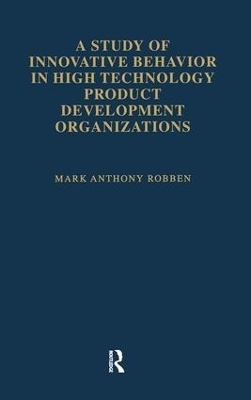
A Study of Innovative Behavior
In High Technology Product Development Organizations
Seiten
1999
Routledge (Verlag)
978-0-8153-3489-7 (ISBN)
Routledge (Verlag)
978-0-8153-3489-7 (ISBN)
- Titel z.Zt. nicht lieferbar
- Versandkostenfrei
- Auch auf Rechnung
- Artikel merken
First published in 1999. This study integrated several streams of research on the antecedents of innovation to test a model of individual innovative behavior in a high technology product development organization. The world we live in today is a globally competitive environment of rapidly changing technologies. Organizations must harness the innovative potential of their employees to create better and novel ways to solve old and new problems or risk becoming extinct. Innovative organizations can gain a competitive advantage over their less innovative competition through better products, faster product development times, and lower priced products.
The research sample used in this study contained Product Engineers, Application Engineers, Lab Technicians, and Product Designers in an Engineering Department responsible for the development of high technology products. Various survey instruments were used to measure individual problem solving style, leader-member exchange, role expectation, and work climate. The Kirton Adaption-Innovation (KAI) inventory, which is used in many countries, was used to evaluate problem solving style. The KAI score is the summation of the three sub-factors, sufficiency versus proliferation of originality, preference for efficiency, and rule/group conformity. In previous use of the KAI in the general population respondents scored consistently high or low in each of the three KAI sub-groups. In this study, innovative people in the high technology product development organization did not follow this general population trend. Unlike previous KAI studies the innovative people indicated a preference for efficiency. This makes intuitive sense in that to be innovative in a complex high technology environment an individual must have a preference toward efficiency to keep the complex information organized. As the complexity of information required in a high technology product development organization increases so must the complexity of innovative people increase.
(D.B.A. dissertation, 1998; revised with new preface and index)
The research sample used in this study contained Product Engineers, Application Engineers, Lab Technicians, and Product Designers in an Engineering Department responsible for the development of high technology products. Various survey instruments were used to measure individual problem solving style, leader-member exchange, role expectation, and work climate. The Kirton Adaption-Innovation (KAI) inventory, which is used in many countries, was used to evaluate problem solving style. The KAI score is the summation of the three sub-factors, sufficiency versus proliferation of originality, preference for efficiency, and rule/group conformity. In previous use of the KAI in the general population respondents scored consistently high or low in each of the three KAI sub-groups. In this study, innovative people in the high technology product development organization did not follow this general population trend. Unlike previous KAI studies the innovative people indicated a preference for efficiency. This makes intuitive sense in that to be innovative in a complex high technology environment an individual must have a preference toward efficiency to keep the complex information organized. As the complexity of information required in a high technology product development organization increases so must the complexity of innovative people increase.
(D.B.A. dissertation, 1998; revised with new preface and index)
Mark Anthony Robbin
Chapter 1: Introduction, Chapter 2: Review of Literature, Chapter 3: Methodology, Chapter 4: Analysis and Presentation of Findings, Chapter 5: Summary and Conclusions
| Erscheint lt. Verlag | 14.10.1999 |
|---|---|
| Reihe/Serie | Studies on Industrial Productivity: Selected Works |
| Verlagsort | New York |
| Sprache | englisch |
| Maße | 138 x 216 mm |
| Gewicht | 453 g |
| Themenwelt | Geschichte ► Teilgebiete der Geschichte ► Technikgeschichte |
| Technik | |
| ISBN-10 | 0-8153-3489-3 / 0815334893 |
| ISBN-13 | 978-0-8153-3489-7 / 9780815334897 |
| Zustand | Neuware |
| Informationen gemäß Produktsicherheitsverordnung (GPSR) | |
| Haben Sie eine Frage zum Produkt? |
Mehr entdecken
aus dem Bereich
aus dem Bereich
Buch | Softcover (2024)
Lehmanns Media (Verlag)
CHF 27,90
Eine superschnelle Menschheitsgeschichte des digitalen Universums
Buch | Hardcover (2024)
Heyne (Verlag)
CHF 33,55


